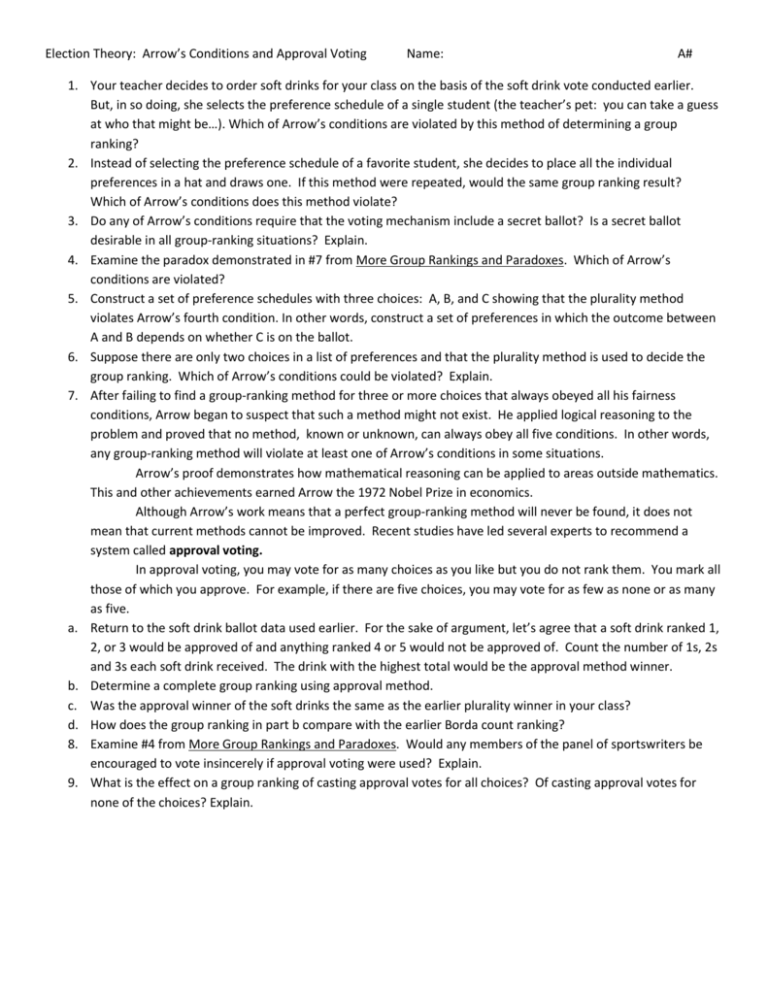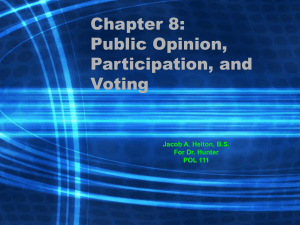Election Theory: Arrow`s Conditions and Approval Voting Name: A#
advertisement

Election Theory: Arrow’s Conditions and Approval Voting
Name:
A#
1. Your teacher decides to order soft drinks for your class on the basis of the soft drink vote conducted earlier.
But, in so doing, she selects the preference schedule of a single student (the teacher’s pet: you can take a guess
at who that might be…). Which of Arrow’s conditions are violated by this method of determining a group
ranking?
2. Instead of selecting the preference schedule of a favorite student, she decides to place all the individual
preferences in a hat and draws one. If this method were repeated, would the same group ranking result?
Which of Arrow’s conditions does this method violate?
3. Do any of Arrow’s conditions require that the voting mechanism include a secret ballot? Is a secret ballot
desirable in all group-ranking situations? Explain.
4. Examine the paradox demonstrated in #7 from More Group Rankings and Paradoxes. Which of Arrow’s
conditions are violated?
5. Construct a set of preference schedules with three choices: A, B, and C showing that the plurality method
violates Arrow’s fourth condition. In other words, construct a set of preferences in which the outcome between
A and B depends on whether C is on the ballot.
6. Suppose there are only two choices in a list of preferences and that the plurality method is used to decide the
group ranking. Which of Arrow’s conditions could be violated? Explain.
7. After failing to find a group-ranking method for three or more choices that always obeyed all his fairness
conditions, Arrow began to suspect that such a method might not exist. He applied logical reasoning to the
problem and proved that no method, known or unknown, can always obey all five conditions. In other words,
any group-ranking method will violate at least one of Arrow’s conditions in some situations.
Arrow’s proof demonstrates how mathematical reasoning can be applied to areas outside mathematics.
This and other achievements earned Arrow the 1972 Nobel Prize in economics.
Although Arrow’s work means that a perfect group-ranking method will never be found, it does not
mean that current methods cannot be improved. Recent studies have led several experts to recommend a
system called approval voting.
In approval voting, you may vote for as many choices as you like but you do not rank them. You mark all
those of which you approve. For example, if there are five choices, you may vote for as few as none or as many
as five.
a. Return to the soft drink ballot data used earlier. For the sake of argument, let’s agree that a soft drink ranked 1,
2, or 3 would be approved of and anything ranked 4 or 5 would not be approved of. Count the number of 1s, 2s
and 3s each soft drink received. The drink with the highest total would be the approval method winner.
b. Determine a complete group ranking using approval method.
c. Was the approval winner of the soft drinks the same as the earlier plurality winner in your class?
d. How does the group ranking in part b compare with the earlier Borda count ranking?
8. Examine #4 from More Group Rankings and Paradoxes. Would any members of the panel of sportswriters be
encouraged to vote insincerely if approval voting were used? Explain.
9. What is the effect on a group ranking of casting approval votes for all choices? Of casting approval votes for
none of the choices? Explain.
10. The voters whose preferences are represented below all feel strongly about their first choices but are not sure
about their second and third choices. They all dislike their fourth and fifth choices. Since the voters are unsure
about their second and third choices, they flip coins to decide whether to give approval votes to their second
and third choices.
A
B
C
D
E
Total # of voters
1
2
3
4
5
22
5
2
4
1
3
20
5
3
2
4
1
18
a. Assuming the voter’s coins come up heads about half the time, how many approval votes would you expect each
of the five choices to get? Explain your reasoning.
b. Do the results seem unfair to you in any way? Explain.
11. Approval voting offers a voter many choices. If there are three candidates for a single office, for example, the
plurality system offers the voter four choices: vote for any one of the three candidates or for none of them.
Approval voting permits the voter to vote for none, any one, any two, or all three.
To investigate the number of ways in which you can vote under approval voting, consider a situation
with two choices, A and B. You can represent voting for none by writing { }, voting for A by writing {A},
voting for B by writing {B}, and voting for both by writing {A, B}.
a. List all the ways of voting under the approval system when there are three choices.
b. List all of the ways of voting under the approval system when there are four choices.
c. Generalize the pattern by letting Vn represent the number of ways of voting under the approval system when
there are n choices and writing a recurrence relation that describes the relationship between Vn and Vn-1.
12. Many patterns can be found in the various ways of voting when the approval system is used. The following table
shows the number of ways of voting for exactly one item when there are several choices on the ballot. For
example, in #11 you listed all the ways of voting when there are three choices on the ballot. Three of these, {A},
{B}, and {C}, are selections of one item. Complete the table.
Number of Choices on the Ballot
Number of Ways of Selecting Exactly One Item
1
1
2
2
3
3
4
5
13. Let V1n represent the number of ways of selecting exactly one item when there are n choices on the ballot and
write a recurrence relation that expresses the relationship between V1n and V1n-1.
14. The following table shows the number of ways of voting for exactly two items when there are from one to five
choices on the ballot. For example, in #11 your list shows that when there are three choices on the ballot, there
are three ways of selecting exactly two items: {A, B}, {A, C}, and {B, C}. Complete the table.
Number of Choices on the Ballot
Number of Ways of Selecting Exactly Two Items
2
1
3
3
4
5
15. Let V2n represent the number of ways of selecting exactly two items when there are n choices on the ballot and
write a recurrence relation that expresses the relationship between V2n and V2n-1. Can you find more than one
way to do this?






